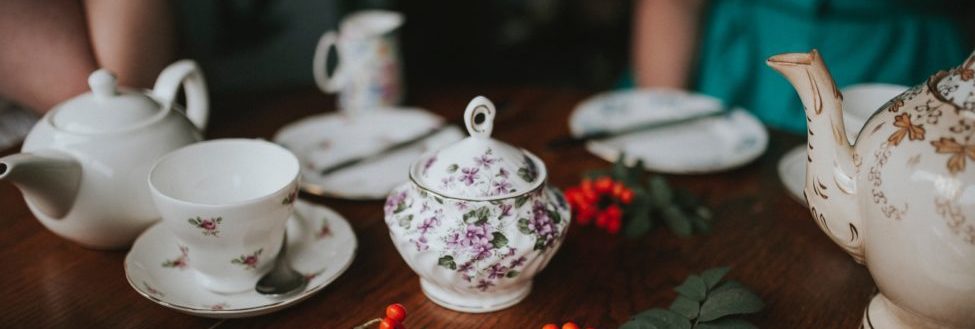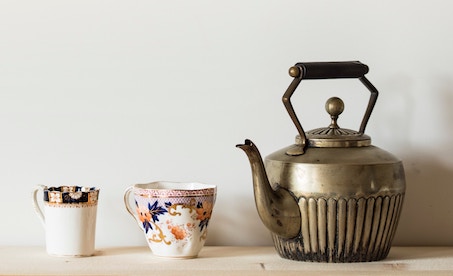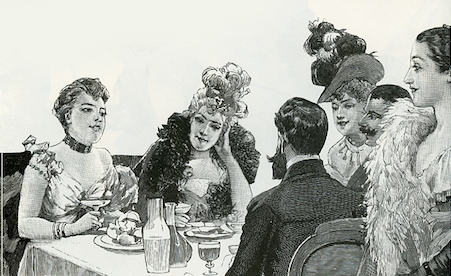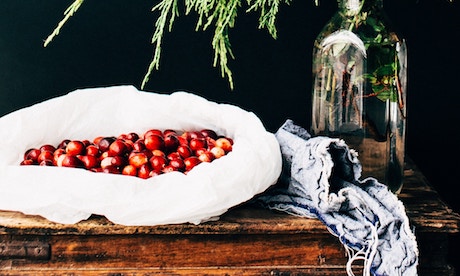Programs Available for Booking
Explore the tabs below to see an up to date collection of programs available for booking.
New Jersey Foods Programs
The New Jersey Cranberry
Cranberries are known by many names, such as, bitter berry, bear berry and the marsh apple. They are among the few fruits indigenous to the United States. Native Americans were using cranberries as food, medicine, and dye long before the Europeans arrived. Cranberries have been an important crop for New Jersey since the 19th century. Learn the history of these tart berries and why they were so important. We will also discuss New Jersey’s contribution to their cultivation. Early American recipes will be discussed.
Apples – Dumplings, Cider and Jack 
Apples, a fruit brought to the United States by the Dutch, found a perfect home in the Garden State. Many varieties were grown in the rich New Jersey soil, some of which can still be found in our state’s orchards. Discover why the apple was so important to early Americans and what role New Jersey played in the growth and production of apple products such as, apple cider and applejack. Learn about some of the different varieties of apples and what food and beverages are made from this versatile fruit.
The Jersey Tomato – From Cherry to Beefsteak

Everyone loves the Jersey Tomato! Discover where the tomato originated and why it became one of New Jersey’s favorite crops. Find out when New Jersey was known for its tomato packing industry and what happened to that industry. Did you know that tomatoes were considered poisonous at one time, and it was a New Jersey resident who decided to prove everyone wrong? Learn about heirloom varieties, modern hybrids and the folklore attached to this fruit.
Strawberry Fields in New Jersey

Red, sweet, juicy strawberries are the first fruits of the season. For ages these scarlet berries have been a symbol of love and perfection. In the 19th century strawberries from Bergen County were considered among the best in the nation. Today strawberries are grown throughout New Jersey for the “pick-your-own” market. Come learn the history and folklore of this fascinating berry.
Blueberries – New Jersey’s Wonder Fruit *

The cultivated blueberry has its roots in the Pinelands of New Jersey. Elizabeth White along with Dr. Fredrick Coville, proved that the “swamp huckleberry” could be cultivated. Learn the history of this fascinating berry and the contributions New Jersey horticulturist Elizabeth White of Whitesbog made to their cultivation in the early 1900s in Burlington County. Today the blueberry is touted as the wonder fruit with a host of healthful benefits. Learn the history, health benefits and a variety of ways to prepare and savor these berries.
Food and Fun Along the Jersey Shore

Discover about the assortment of foods that have been associated with the Jersey Shore over the years such as salt-water taffy and clam fritters. The foods identified with the Atlantic shoreline along with the lesser known Delaware River and Bay coastline will also be explored. We will also talk about the various summer activities that have been connected with the Jersey shoreline.
Corn-Simply A-Maize-ing

Sweet corn, golden ears of delicious sweet corn, is a sure sign that it is summer in New Jersey. There are six main kinds of corn, but it is hot, buttered sweet corn we crave. Corn once also called maize is an ancient New World grass, grain, vegetable. It was highly valued by our Native North Americans, Incas, and Aztecs. Corn was given as tribute to their gods, it was used as money, and a most important food source. Come learn the fascinating history of corn and its folklore from ancient times to today’s modern farmers in New Jersey.
New Jersey’s Agricultural Inventions, Innovations, and Discoveries

New Jersey produces an abundance of crops ranging from blueberries, cranberries, and peaches to the renowned Jersey Tomato. Agriculturally speaking, New Jersey is known for developing the cultivated blueberry from the wild swamp huckleberry, perfecting wet harvesting for cranberries, and patenting the famous Deats plow.Come and learn about other agricultural inventions, innovations, and discoveries made in the Garden State.
The New Jersey Greenwich Tea Party

As we all learned in school, The Boston Tea Party is a well-known rebellious act in the American fight for freedom. But did you know there were many such rebellious “tea parties” throughout the colonies, one of which occurred in 1774 in the southern New Jersey village of Greenwich. Learn about this Tea Party and the importance this area of the state has played in industry, agriculture, and manufacturing from colonial times.
Tea Programs
History of English Tea

Discover the fascinating history of this much–loved beverage! Tea was first introduced to England in the 17th century. At first, it was used for medicinal purposes and sold in London’s early coffee houses. Only when Catherine of Braganza (an avid tea drinker) of Portugal married England’s Charles II did tea become a social beverage. In 1840, Anna the 7th Duchess of Bedford is credited with inventing the custom of Afternoon Tea, a tradition that was embraced by Queen Victoria. Understand the difference between High Tea and Afternoon Tea and learn proper tea etiquette and customs.
Tea and the Mad Hatter

Remember Alice and the Mad Hatter’s Tea party? In the 1860s when Lewis Carol wrote his Alice books, tea gatherings were very popular with people of all classes. Today we will not only learn the history of this much-loved beverage but also some of Lewis Carol’s social comments on the Victorian Age. Proper tea etiquette will be discussed. Wear your most fabulous hat.
Tea, Food, and Fashion from Jane Austen to Queen Victoria

Jane Austen’s life in the Regency Era has many similarities to the Victorian Era but also many differences. Learn about tea, food, fashion and more in these two different time periods. Discover how the Industrial Revolution had an impact on these two eras.
Women and Tea in the Victorian Era

Tea was introduced to England in the middle of the 17th century. It was an exotic and very expensive beverage. At first, it could be only purchased in coffee houses which respectable women could not enter. It wasn’t until the early 18th century when the Golden Lyon Tea Shop was opened by the Twining family in London, that women could purchase tea. Of course, a woman could only do this when accompanied by a man. Tea remained an expensive and prestigious beverage for many years. However, by the middle of the 19th century, the price of tea was no longer exorbitant and
tea was available for consumption by all social classes. Learn how tea had an impact on both upper- and working-class women. Discover how tea affected women’s social events, dress styles, business, and health.
English Tea and Royal Weddings

For centuries the British have had a love affair with tea. All classes, from the aristocracy to the working class, enjoy a nice hot cup of tea. They also enjoy the excitement and fanfare of their monarchs’ royal weddings. Learn about English tea traditions and etiquette along with royal wedding customs and ceremonies.
Ireland – Tea, Food and Folklore
 The Emerald Isle – Ireland, where folks drink numerous cups of strong black tea throughout the day and night and nibble on scones or tea cakes. Hearty and filling foods are consumed at home or in pubs that dot the countryside and cities. People are friendly and known for their hospitality. Ireland is a country where myths and legends live along with leprechauns and fairies. Come learn about this enchanted land – Ireland.
The Emerald Isle – Ireland, where folks drink numerous cups of strong black tea throughout the day and night and nibble on scones or tea cakes. Hearty and filling foods are consumed at home or in pubs that dot the countryside and cities. People are friendly and known for their hospitality. Ireland is a country where myths and legends live along with leprechauns and fairies. Come learn about this enchanted land – Ireland.
Tea and Other Meals in Victorian America

The years after the Civil War ushered in many changes in the eating habits of Victorian America. Etiquette around the table became very important, tea parties were popular, and soda fountains became the social center. Come learn more about food and drink in 19th Century America.
Valentine’s Day -Tea, Flowers, Fans, and Chocolate

Tea was introduced to England in the 17th century and soon became a popular but expensive beverage. By the mid -19th century, as the price of tea decreased and with Queen Victoria’s passion for tea and sweets, the tea party became a popular pastime and a time to flirt. During her reign, the romantic concept of Valentine’s Day flourished. It was a time when Valentine’s Day cards were sent and ladies flirted using fans and flowers, to convey romantic messages to available men. In England by 1868 chocolate candy could be purchased in a decorated tin and soon the Valentine candy box was born. Learn about the language of fans, flowers, the romance of chocolate, and the history of Valentine’s Day.
Tea Traditions from Around the World

Let’s take a tea trip around the world and discover various tea customs and rituals. We will start where it all began – China, and travel through such countries such as India, Japan, Russia, Turkey, and the British Isles. Learn how various cultures celebrate the wonderful tradition known as tea-time. On display will be an array of tea accoutrements including a Russian samovar (circa 1900), Chinese Gong Fu tea set, Turkish teapot and Tibetan tea bowl.
Tea Knowledge – A Basic Tea Primer

Tips on Buying, Brewing, and Storing Tea for the Professional and Non-professional
Tea is now all the rage. Television and newspapers tout the pleasures and health benefits of drinking tea. Companies tell you to drink white tea, green tea, oolong tea and flavored tisanes. (By the way, what is a “tisane”?)
Today we will discover the differences among teas and what countries are noted for their tea growing traditions. Learn what to look for when buying loose tea and tea bags. Did you know that each tea has its own recipe for brewing in order to bring out its best flavor and aroma? You will learn methods of properly brewing different teas as well as the correct storage methods to preserve the wonderful taste and aroma.
Note : Limited attendees. Special time frame and program fee.
The Asian Tea Experience

The Far East has had a long history of drinking tea. For many it is an everyday occurrence. People enjoy this beverage from a simple bowl of tea, to the beautiful and intricate tea ceremonies. Learn about the Japanese tea ceremony, China’s Gong Fu Cha and the customs of Korea and Viet Nam. There will be a collection of tea sets on display, as well as various types of tea.
Historical Programs
The Gilded Age – A Journey Back in Time

Call it Gotham, call it The Great Metropolis or just call it New York City, it was the center of the Gilded Age (1870 -1900). During the Civil War the seeds of The Gilded Age were planted and by 1870 wealth was growing by leaps and bounds due to industrialization, railway development, mechanization and so much more. The Nouveau riche (new money) climbing the social ladder wanted to be accepted into New York City society’s old money known as the Knickerbockers. The Gilded Age was coined by Mark Twain to satirize the time of poverty and corruption masked by a thin layer of gold gilding. Come discover the wealth, glamor, high society’s “400” as well as the corruption, poverty and scandals of this exciting and at times depressing era.
Celebrating the Harvest Season

Autumn was a season of hard work for early Americans. Neighbors joined together to help each other during harvest time. Numerous hands were needed to butcher, preserve, and prepare many foods. School was cancelled for days so children could help their parents with the harvest chores. The fruits of spring and summer labor were enjoyed during this season, which was also a time of feasting and recreation. Learn how our forefathers prepared for the long winter ahead while celebrating the harvest season.
Remedies from the Kitchen

Learn some of the history and folklore of home remedies. Long before pharmacies people concocted their own remedies for everything from coughs and sore throats to hiccups, and hangovers. Our ancestors relied mainly on everyday foods that could be found in the kitchen or garden such as honey, spices, onions, garlic, and herbs. Some of the information you will learn today is practical, some will be humorous and some will be downright bizarre.
Note: This workshop is not meant to take the place of your medical practitioner’s advice.
Favorite Foods and Libations of Presidential Families

Put aside partisan political views and look at the lighter side of the presidential office. Learn about some of the favorite foods and beverages of past presidential families. Learn how the Presidents entertained at State dinners and how they entertained family and friends. Did you know that George Washington loved honey, and Martha had a great fondness for cake? A favorite beverage of President Garfield was tea; he even had his own recipe for a herb tea that included catnip. Thomas Jefferson never invited more than 12 guests for dinner. Come learn about other past presidential families and their favorite fare.
Colonial and Victorian Christmas Customs

Decorations of holly and mistletoe, gingerbread and caroling, these are just a few of the Christmas customs that have been handed down from earlier times. Learn the similarities and differences between a Colonial Christmas and a Victorian Christmas celebration. Discover what foods were prepared and enjoyed as part of the holiday festivities.
Christmas Traditions Around the World

Christmas is the time for family, friends, food, and festivities. Midnight Mass, burning the Yule log, toasting with wassail, lightning bamboo star lanterns, and bonfires in the Outback are all ways that people from around the world celebrate Christmas. Discover how countries such as England, Italy, Australia, and The Philippines and more celebrate this most cherished holiday
Winter Holidays

Winter — when the days are short and the nights are long. This is the perfect time to bring family and friends together for warm festivities. Learn the history, customs, and foods of various winter celebrations, including, Victorian Christmas, Hanukkah, Ancient Rome’s Saturnalia and the Winter Solstice.
The African Influence in Foods

Okra, black-eyed peas, and yams are a few of the foods brought to this continent by the African slaves. The influence of African cooking can be seen in the cuisines of the Caribbean, Brazil, New Orleans, and our Deep South. Join us to learn how Africa influenced and inspired many of our favorite dishes.
Eating and Drinking Customs during the Civil War

As you can imagine, during the Civil War life was tough for soldiers and civilians alike.The lingering War made many harsh demands on both food and everyday essentials. As the war progressed, everyday food items became scarce, such as coffee, tea, and wheat.
- Learn what substitutes soldiers and civilians used to meet everyday needs.
- Learn the advantages the North had over the South with regard to 19th-century agriculture and industrial practices.
- Discover how prior to the War the South was dependent on the North for many of its major food essentials.
Find out how the War ushered in a new era of food processing, transportation, and new social attitudes.
Ladies Luncheons, Cocktail Parties and Backyard Grilling in the 1950s

Say the 1950s and our minds drift back to a more nostalgic time of “Father Knows Best”, 45 RPM records, black and white televisions, and “I like Ike”. After the hardships of the war years, women entertained more and ladies’ luncheons and cocktail parties became very popular and men became masters of the grill.
Join us and learn how to entertain in a 1950’s style. Wearing a 1950’s outfit is encouraged but not required.
Eastern European Food Traditions

Come learn about the cuisines of several East European countries such as: Poland, the Ukraine, Hungary, the Czech Republic and Romania. Learn what meals are similar in these counties and which are different. Find out what outside cultures influenced their local cuisine. New Jersey is home to many fine Eastern European eating establishments; a list will be provided for attendees.
The Victorian and Edwardian Era
Victorian Parlor Games

The Victorians loved to entertain, and the best way to entertain was to play games. In the 19th century, before electronics changed our habits, people gathered in homes for entertainment and played parlor or board games for recreation. The host or hostess might plan seven or eight games to be played throughout the evening with perhaps a light refreshment between games. Learn some old-fashioned games such as, Lookabout, Change Seats! and Pass the Slipper. Be prepared to play and have fun!
Life at an Edwardian Manor – Inspired by Downton Abbey

The critically acclaimed TV Series, “Downton Abbey,” has renewed popular interest in the Edwardian era, when King Edward VII reigned in the United Kingdom. It was a time of great disparity between the haves and the have-nots. Wealthy aristocrats owned huge manor houses and revelled in luxury, leisure, and extravagant entertaining. The rich expected their every whim to be indulged, and all their daily needs to be fulfilled, by the lower class of domestic servants. This “Golden Age,” which was a reaction to the Victorian era (and actually began in the late 19th century), perched on a shaky foundation as the winds of change brought a time of greater social mobility within the rigid British class system. Come learn about this fascinating time and the people who lived in it.
Though you don’t have to be a “Downton Abbey” fan to enjoy this program, devoted fans may take more notice of certain details in the show after attending.
Life as a Domestic Servant

In the Victorian and Edwardian Eras, domestics represented a large majority of jobs available for the working class. A servant’s main objective was to make the employer’s life as easy and carefree as possible. Their every whim and desire should be fulfilled no matter the time or energy from the employee/servant. The servant was secondary to the needs of the owner and its occupants of the house. In a grand house similar to Downton Abbey, one would strive to become a lady’s maid or a gentlemen’s valet. These positions took years to obtain after many long days and hours and not everyone became one of the “Upper Ten”.
The majority of servants did not work for the upper class but rather were employed by middle to lower class families. This, by all means, did not mean they had an easier life. Learn about a servant’s day which started from early morning and lasted late into the night. What was a typical servant’s meal like? What type of clothes did they wear? How did they entertain themselves? And what happened when other job opportunities started to open up for the working class.
Mealtime with the Victorians

Meals in the Victorian Era (1837-1901) were vastly different than what we are accustomed to today. The wealthy dined on multi- course meals (sometimes up to twenty courses), while the poor barely had enough to sustain themselves. Since many of the urban poor had no oven or fireplace to use for cooking, many of their meals were purchased from street peddlers. Popular street fare at the time included sheep trotters (feet), eels, and bloaters (whole cold smoked herring). Discover how, what and when the different classes ate their meals, and how tea was one item consumed by every socio-economic class.There will be a display of Victorian serving utensils such as a pickle caster, banana boat, salt cellar and more.
Women and Tea in the Victorian Era

Tea was introduced to England in the middle of the 17th century. It was an exotic and very expensive beverage. At first it could be only purchased in coffee houses which respectable women could not enter. It wasn’t until the early 18th century, when the Golden Lyon Tea Shop was opened by the Twining family in London, that women could purchase tea. Of course, a woman could only do this when accompanied by a man. Tea remained an expensive and prestigious beverage for many years. However, by the middle of the 19th century, the price of tea was no longer exorbitant
and tea was available for consumption by all social classes. Learn how tea had an impact on both upper- and working-class women. Discover how tea affected women’s social events, dress styles, business, and health.
Tea and Other Meals in Victorian America

The years after the Civil War ushered in many changes in the eating habits of Victorian America. Etiquette around the table became very important, tea parties were popular, and soda fountains became the social center. Come learn more about food and drink in 19th Century America.
Tea, Food, and Fashion from Jane Austen to Queen Victoria

Jane Austen’s life in the Regency Era had many similarities to the Victorian Era but also many important differences. Learn about tea, food, and fashion in these two different time periods. Discover how the Industrial Revolution had an impact on these two era.



